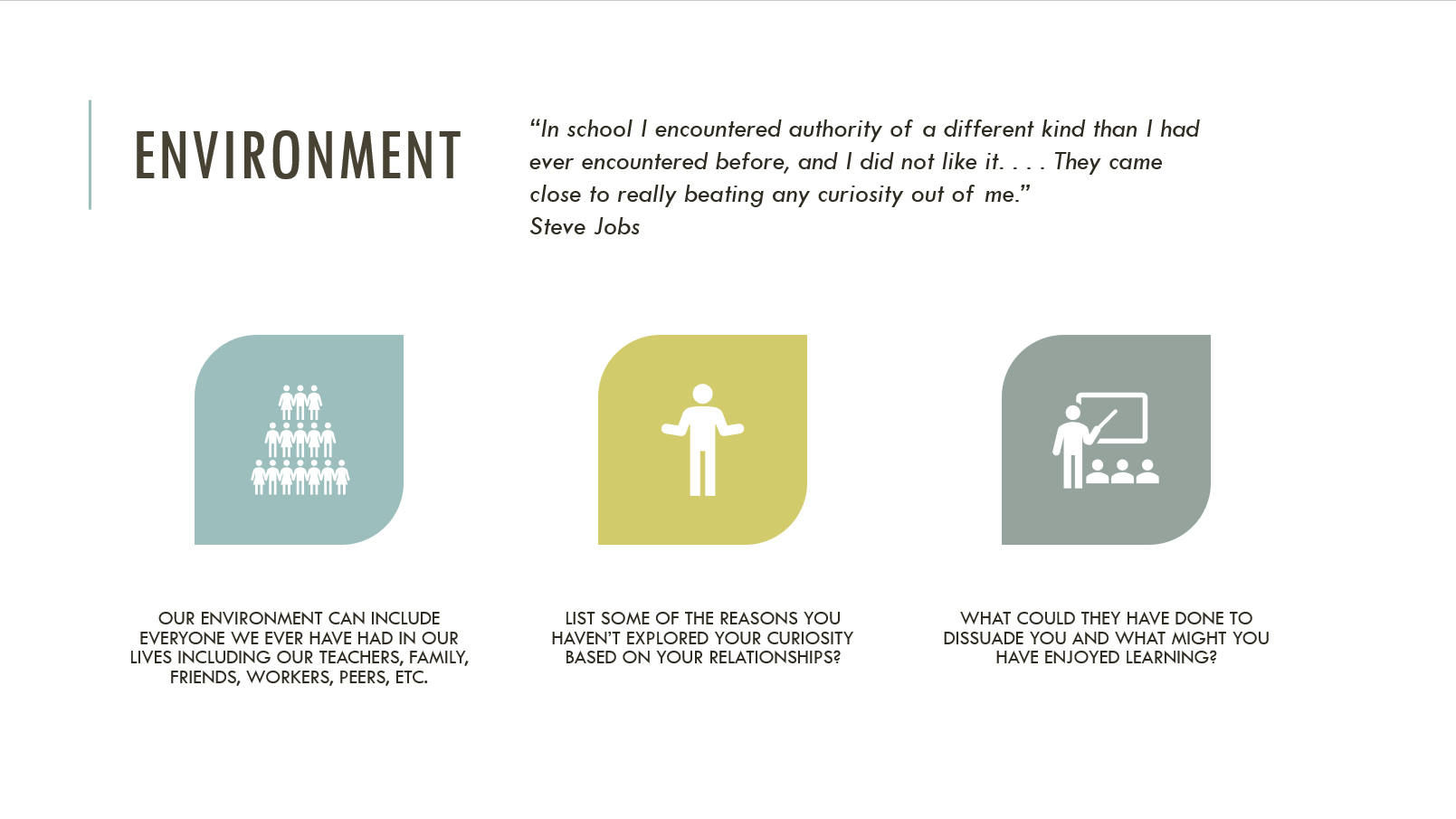Environment – Chapter Reading

When considering curiosity, our environment includes the hopes, dreams, guidance, expectations, opinions, and instructions given to us throughout our lives. All are powerful in shaping who we are and who we become. Our indoctrination begins with our parents and continues with our teachers, coaches, ministers, college professors, politicians, bosses, colleagues, next-door neighbors, and all the other influential figures in our lives. Their messages, positive or negative, shape our own beliefs, attitudes, and behaviors. They also shape our curiosity.
We’re either being encouraged or discouraged in our curiosity. We’re being influenced as to what we should be curious about, as well as what to accept as givens.
This shaping begins with our parents.
As children, we want to know everything! From, why do birds have feathers on their faces, to how are horses different from mules, our endless questions are all over the map. Every response to those questions either encourages or suppresses our curiosity.
The nonstop questions of a four-year-old can take their toll on an overworked, exasperated parent. Unfortunately, “just because” isn’t an answer that engenders a child’s curiosity.
As astronomer and author Neil deGrasse Tyson put it, “Kids are born scientists. They are curious about everything around them. And a parent can either respond ‘Let’s find out’ or ‘Stop asking so many questions!’”
Input continues with our teachers and education system.
Researchers and behavioral scientists have long decried that our education system places more emphasis on maintaining order and teaching answers than it does encouraging questions or curiosity. Teachers are given curricula and lesson plans to administer. Standardized tests measure students’ proficiency as well as teachers’ effectiveness. Rarely, if ever, are teachers measured on how much curiosity they instilled in their students.
Doug Bergum is an American entrepreneur, philanthropist, and politician serving as the thirty-third and current governor of North Dakota. In a TED talk, he spoke at length about the environmental pressures from parents, teachers, religious leaders, and others to conform to conventional wisdom.
He then described discoveries such as those resulting from Columbus’s voyage to the New World and innovations such as those by the Wright Brothers, Thomas Edison, and others. These discoveries and innovations, he said, required two critical ingredients: perseverance and courageous curiosity.
He spoke of the many failures each of these pioneers endured before realizing their success. He cited their determination to persevere and their courageous curiosity in an environment filled with doubt, ridicule, and in some cases, physical harm. Our environment, he claimed, is dominated by answers and devoid of questions. “It’s like gravity,” he added. “It holds us down, and it’s only by perseverance and courageous curiosity that we are able to defy that gravitational pull.”
He concluded his remarks by revealing that when he dropped off his kids at school each morning, instead of saying, “Have a nice day,” he’d tell them, “Ask great questions today.”
Developmental psychologists Barbara Tizard and Martin Hughes conducted research and found that while kindergarten-age children asked an average of twenty-seven questions an hour at home, that number plummeted to only about three when they were at school. Some of this drop-off, the authors concluded, is unavoidable. Kids at school don’t have the opportunity to ask questions endlessly as they might at home. However, this could be off-set somewhat if the school environment would encourage children to be more curious.
Many are convinced that curiosity is drastically underappreciated in our educational institutions. Susan Engel, author of The Hungry Mind, said that amidst the country’s standardized testing mania, schools are missing what most matters about learning, the desire to learn in the first place. From her studies, teachers rarely encourage curiosity in the classroom, even though that’s the one factor that can most influence learning.
Leslie Crawford, senior editor at Great Schools, described behaviors of parents and teachers that can have a subtle but lasting effect on a child’s curiosity. She mentioned behaviors such as overreacting to a child’s mess, choosing what a child should study, over-scheduling a child’s time, being overly concerned with safety, and having all the answers. Each of these behaviors can suppress natural curiosity in children.
The author asserted that the messy but creative art of slime-making, so popular among children, can engender the scientists, engineers, and inventors of the future. She admonished, let them make messes!
Beneficial environmental influences such as the STEM (science, technology, engineering, and mathematics) Program and the Curiosity Cube are attempting to stimulate and sustain the innate curiosity of children. The program encourages a curriculum in schools to improve competitiveness in the science and technology fields. The Curiosity Cube is a renovated shipping container turned into a traveling learning laboratory. Sponsored by the Millipore organization, the Curiosity Cube encourages students to explore subjects in the areas of science, technology, and engineering.
***
In conclusion, the shaping and coaching process of our environment continues from our childhoods well into our adult lives and, in reality, is never-ending. From our parents, teachers, and pastors to our bosses and even media advertising, the messaging is nonstop. It’s all in pursuit of our mindshare and either encourages or represses our curiosity. In a world dominated by policies, procedures, rules, and guidelines, traits such as creativity and innovation are the domain of the curious and the courageous.
Thus, the influences of our environment along with the elements of FATE most affect our level of curiosity.
For us as individuals and for the companies that employ us, to what degree do FATE factors control our curiosity? In turn, to what extent does this control obstruct our creativity, innovation, and productivity? Most important, to what extent can those barriers be torn down, thereby unleashing the creativity, innovation, and productivity within us and within our companies?
Those questions are for us to answer with the help of the Curiosity Code Index that accompanies this book. A preview of the Code is presented in Chapter 17.